Fatigue Resistance of Dissected Lower First Molars Restored with Direct Fiber-Reinforced Bridges—An In Vitro Pilot Study
Abstract
1. Introduction
2. Materials and Methods
2.1. Sample Selection
2.2. Sample Preparation
2.3. Direct Bridge Fabrication
2.4. Embedding of the Samples
2.5. Mechanical Testing
3. Results
4. Discussion
5. Conclusions
Author Contributions
Funding
Institutional Review Board Statement
Informed Consent Statement
Data Availability Statement
Acknowledgments
Conflicts of Interest
References
- Krebs, M.; Kesar, N.; Begić, A.; Von Krockow, N.; Nentwig, G.; Weigl, P. Incidence and prevalence of peri-implantitis and peri-implant mucositis 17 to 23 (18.9) years postimplant placement. Clin. Implant. Dent. Relat. Res. 2019, 21, 1116–1123. [Google Scholar] [CrossRef] [PubMed]
- Wada, M.; Mameno, T.; Otsuki, M.; Kani, M.; Tsujioka, Y.; Ikebe, K. Prevalence and risk indicators for peri-implant diseases: A literature review. Jpn. Dent. Sci. Rev. 2021, 57, 78–84. [Google Scholar] [CrossRef] [PubMed]
- Sousa, V.; Mardas, N.; Farias, B.; Petrie, A.; Needleman, I.; Spratt, D.; Donos, N. A systematic review of implant outcomes in treated periodontitis patients. Clin. Oral Implant. Res. 2015, 27, 787–844. [Google Scholar] [CrossRef]
- Szabó, B.; Garoushi, S.; Braunitzer, G.; Baráth, Z.; Fráter, M. Fracture behavior of root-amputated teeth at different amount of periodontal support–a preliminary in vitro study. BMC Oral Health 2019, 19, 261. [Google Scholar] [CrossRef]
- Megarbane, J.-M.; Kassir, A.R.; Mokbel, N.; Naaman, N. Root Resection and Hemisection Revisited. Part II: A Retrospective Analysis of 195 Treated Patients with Up to 40 Years of Follow-up. Int. J. Periodontics Restor. Dent. 2018, 38, 783–789. [Google Scholar] [CrossRef] [PubMed]
- El Sayed, N.; Cosgarea, R.; Rahim, S.; Giess, N.; Krisam, J.; Kim, T.-S. Patient-, tooth-, and dentist-related factors influencing long-term tooth retention after resective therapy in an academic setting—a retrospective study. Clin. Oral Investig. 2019, 24, 2341–2349. [Google Scholar] [CrossRef]
- Desanctis, M.; Murphy, K.G. The role of resective periodontal surgery in the treatment of furcation defects. Periodontology 2000 2000, 22, 154–168. [Google Scholar] [CrossRef]
- Carnevale, G.; Pontoriero, R.; Hürzeler, M.B. Management of furcation involvement. Periodontology 2000 1995, 9, 69–89. [Google Scholar] [CrossRef] [PubMed]
- Naveen, Y.G.; Patel, J.R.; Parikh, P.; Shah, K. Alternatives for restoration of a hemisected mandibular molar. BMJ Case Rep. 2014, 2014, bcr2013010275. [Google Scholar] [CrossRef]
- Dannewitz, B.; Krieger, J.K.; Hüsing, J.; Eickholz, P. Loss of molars in periodontally treated patients: A retrospective analysis five years or more after active periodontal treatment. J. Clin. Periodontol. 2006, 33, 53–61. [Google Scholar] [CrossRef]
- Ahmed, K.E.; Li, K.Y.; Murray, C.A. Longevity of fiber-reinforced composite fixed partial dentures (FRC FPD)—Systematic review. J. Dent. 2017, 61, 1–11. [Google Scholar] [CrossRef] [PubMed]
- Perea-Lowery, L.; Vallittu, P.K. Framework design and pontics of fiber-reinforced composite fixed dental prostheses—An overview. J. Prosthodont. Res. 2018, 62, 281–286. [Google Scholar] [CrossRef] [PubMed]
- Vallittu, P.K.; Shinya, A.; Baraba, A.; Kerr, I.; Keulemans, F.; Kreulen, C.; Lassila, L.; Malmstrom, H.; Novotny, R.; Peumans, M.; et al. Fiber-reinforced composites in fixed prosthodontics—Quo vadis? Dent. Mater. 2017, 33, 877–879. [Google Scholar] [CrossRef] [PubMed]
- Perrin, P.; Meyer-Lueckel, H.; Wierichs, R. Longevity of immediate rehabilitation with direct fiber reinforced composite fixed partial dentures after up to 9 years. J. Dent. 2020, 100, 103438. [Google Scholar] [CrossRef]
- Vallittu, P.; Matinlinna, J. Types of Frcs Used in Dentistry. In Clinical Guide to Principles of Fiber-Reinforced Composites in Dentistry; Vallittu, P., Özcan, M., Eds.; Woodhead Publishing Ltd: Cambridge, MA, USA, 2017; pp. 11–34. [Google Scholar]
- Vallittu, P.K. Survival rates of resin-bonded, glass fiber–reinforced composite fixed partial dentures with a mean follow-up of 42 months: A pilot study. J. Prosthet. Dent. 2004, 91, 241–246. [Google Scholar] [CrossRef] [PubMed]
- van Heumen, C.C.M.; Kreulen, C.M.; Creugers, N.H.J. Clinical studies of fiber-reinforced resin-bonded fixed partial dentures: A systematic review. Eur. J. Oral Sci. 2009, 117, 1–6. [Google Scholar] [CrossRef] [PubMed]
- Kumbuloglu, O.; Özcan, M.; User, A. Fracture Strength of Direct Surface-retained Fixed Partial Dentures: Effect of Fiber Reinforcement versus the Use of Particulate Filler Composites Only. Dent. Mater. J. 2008, 27, 195–202. [Google Scholar] [CrossRef] [PubMed]
- Cekic-Nagas, I.; Egilmez, F.; Ergun, G.; Vallittu, P.K.; Lassila, L.V.J. Load-bearing capacity of novel resin-based fixed dental prosthesis materials. Dent. Mater. J. 2018, 37, 49–58. [Google Scholar] [CrossRef]
- Ang, Y.; Tan, C.G.; Yahaya, N. In-vitro performance of posterior fiber reinforced composite (FRC) bridge with different framework designs. Dent. Mater. J. 2021, 40, 584–591. [Google Scholar] [CrossRef]
- Ellakwa, A.E.; Shortall, A.C.; Shehata, M.K.; Marquis, P.M. The influence of fibre placement and position on the efficiency of reinforcement of fibre reinforced composite bridgework. J. Oral Rehabil. 2001, 28, 785–791. [Google Scholar] [CrossRef]
- Özcan, M.; Breuklander, M.; Salihoglu-Yener, E. Fracture resistance of direct inlay-retained adhesive bridges: Effect of pontic material and occlusal morphology. Dent. Mater. J. 2012, 31, 514–522. [Google Scholar] [CrossRef] [PubMed]
- Molnár, J.; Fráter, M.; Sáry, T.; Braunitzer, G.; Vallittu, P.K.; Lassila, L.; Garoushi, S. Fatigue performance of endodontically treated molars restored with different dentin replacement materials. Dent. Mater. 2022, 38, e83–e93. [Google Scholar] [CrossRef]
- Fráter, M.; Sáry, T.; Vincze-Bandi, E.; Volom, A.; Braunitzer, G.; Balázs Szabó, P.; Garoushi, S.; Forster, A. Fracture Behavior of Short Fiber-Reinforced Direct Restorations in Large MOD Cavities. Polymers 2021, 13, 2040. [Google Scholar] [CrossRef] [PubMed]
- Fráter, M.; Sáry, T.; Braunitzer, G.; Szabó, P.B.; Lassila, L.; Vallittu, P.K.; Garoushi, S. Fatigue failure of anterior teeth without ferrule restored with individualized fiber-reinforced post-core foundations. J. Mech. Behav. Biomed. Mater. 2021, 118, 104440. [Google Scholar] [CrossRef]
- Fráter, M.; Sáry, T.; Néma, V.; Braunitzer, G.; Vallittu, P.; Lassila, L.; Garoushi, S. Fatigue failure load of immature anterior teeth: Influence of different fiber post-core systems. Odontology 2020, 109, 222–230. [Google Scholar] [CrossRef] [PubMed]
- Garoushi, S.; Vallittu, P.K. Mechanical Properties and Wear of Five Commercial Fibre-Reinforced Filling Materials. Chin. J. Dent. Res. 2017, 20, 137–143. [Google Scholar] [CrossRef] [PubMed]
- Garoushi, S.; Gargoum, A.; Vallittu, P.K.; Lassila, L. Short fiber-reinforced composite restorations: A review of the current literature. J. Investig. Clin. Dent. 2018, 9, e12330. [Google Scholar] [CrossRef]
- Garoushi, S.; Lassila, L. Fibre-reinforced Composite in Clinical Dentistry. Chin. J. Dent. Res. 2009, 12, 7–14. [Google Scholar]
- Fráter, M.; Sáry, T.; Jókai, B.; Braunitzer, G.; Säilynoja, E.; Vallittu, P.K.; Lassila, L.; Garoushi, S. Fatigue behavior of endodontically treated premolars restored with different fiber-reinforced designs. Dent. Mater. 2021, 37, 391–402. [Google Scholar] [CrossRef]
- Fráter, M.; Sáry, T.; Molnár, J.; Braunitzer, G.; Lassila, L.; Vallittu, P.K.; Garoushi, S. Fatigue performance of endodontically treated premolars restored with direct and indirect cuspal coverage restorations utilizing fiber-reinforced cores. Clin. Oral Investig. 2021, 26, 3501–3513. [Google Scholar] [CrossRef]
- Garoushi, S.; Sungur, S.; Boz, Y.; Ozkan, P.; Vallittu, P.K.; Uctasli, S.; Lassila, L. Influence of short-fiber composite base on fracture behavior of direct and indirect restorations. Clin. Oral Investig. 2021, 25, 4543–4552. [Google Scholar] [CrossRef]
- Mangoush, E. Influence of Short Fiber Reinforced Composites on Fracture Resistance of Single-Structure Restorations. Eur. J. Prosthodont. Restor. Dent. 2020, 28, 189–198. [Google Scholar] [CrossRef] [PubMed]
- Szabó, V.T.; Szabó, B.; Paczona, B.; Mészáros, C.; Braunitzer, G.; Szabó, P.B.; Garoushi, S.; Fráter, M. The biomechanical effect of root amputation and degree of furcation involvement on intracoronally splinted upper molar teeth – An in vitro study. J. Mech. Behav. Biomed. Mater. 2022, 129, 105143. [Google Scholar] [CrossRef] [PubMed]
- Cara, R.; Fleming, G.; Palin, W.; Walmsley, A.; Burke, F. Cuspal deflection and microleakage in premolar teeth restored with resin-based composites with and without an intermediary flowable layer. J. Dent. 2007, 35, 482–489. [Google Scholar] [CrossRef] [PubMed]
- Szabó, V.T.; Szabó, B.; Tarjányi, T.; Szőke-Trenyik, E.; Fráter, M. Analog and digital modeling of sound and impaired periodontal supporting tissues during mechanical testing. Analecta Tech. Szeged. 2021, 15, 84–97. [Google Scholar] [CrossRef]
- Szabó, B.; Gabriella, E.; Fráter, M. Gyökéramputált és betéttel restaurált felső moláris fogak törési ellenállásának in vitro vizsgálata. Fogorvosi Szle. 2017, 110, 111–116. [Google Scholar] [CrossRef]
- Le Bell-Rönnlöf, A.-M.; Lassila, L.V.; Kangasniemi, I.; Vallittu, P.K. Load-bearing capacity of human incisor restored with various fiber-reinforced composite posts. Dent. Mater. 2011, 27, e107–e115. [Google Scholar] [CrossRef]
- Magne, P.; Carvalho, A.; Bruzi, G.; Anderson, R.; Maia, H.; Giannini, M. Influence of No-Ferrule and No-Post Buildup Design on the Fatigue Resistance of Endodontically Treated Molars Restored with Resin Nanoceramic CAD/CAM Crowns. Oper. Dent. 2014, 39, 595–602. [Google Scholar] [CrossRef]
- Soares, L.M.; Razaghy, M.; Magne, P. Optimization of large MOD restorations: Composite resin inlays vs. short fiber-reinforced direct restorations. Dent. Mater. 2018, 34, 587–597. [Google Scholar] [CrossRef]
- Lazari, P.C.; de Carvalho, M.A.; Del Bel Cury, A.A.; Magne, P. Survival of extensively damaged endodontically treated incisors restored with different types of posts-and-core foundation restoration material. J. Prosthet. Dent. 2018, 119, 769–776. [Google Scholar] [CrossRef]
- Gresnigt, M.M.; Özcan, M.; Carvalho, M.; Lazari, P.; Cune, M.S.; Razavi, P.; Magne, P. Effect of luting agent on the load to failure and accelerated-fatigue resistance of lithium disilicate laminate veneers. Dent. Mater. 2017, 33, 1392–1401. [Google Scholar] [CrossRef] [PubMed]
- Vallittu, P.K. High-aspect ratio fillers: Fiber-reinforced composites and their anisotropic properties. Dent. Mater. 2015, 31, 1–7. [Google Scholar] [CrossRef] [PubMed]
- Özcan, M.; Koekoek, W.; Pekkan, G. Load-bearing capacity of indirect inlay-retained fixed dental prostheses made of particulate filler composite alone or reinforced with E-glass fibers impregnated with various monomers. J. Mech. Behav. Biomed. Mater. 2012, 12, 160–167. [Google Scholar] [CrossRef]
- Garoushi, S.; Lassila, L.V.; Tezvergil, A.; Vallittu, P.K. Load bearing capacity of fibre-reinforced and particulate filler composite resin combination. J. Dent. 2006, 34, 179–184. [Google Scholar] [CrossRef] [PubMed]
- Perea, L.; Matinlinna, J.P.; Tolvanen, M.; Vallittu, P.K. Fracture behavior of pontics of fiber-reinforced composite fixed dental prostheses. Dent. Mater. J. 2015, 34, 746–753. [Google Scholar] [CrossRef]
- Freilich, M.A.; Meiers, J.C.; Duncan, J.P.; Eckrote, K.A.; Goldberg, A.J. Clinical evaluation of fiber-reinforced fixed bridges. J. Am. Dent. Assoc. 2002, 133, 1524–1534. [Google Scholar] [CrossRef]
- Lassila, L.; Keulemans, F.; Säilynoja, E.; Vallittu, P.K.; Garoushi, S. Mechanical properties and fracture behavior of flowable fiber reinforced composite restorations. Dent. Mater. 2018, 34, 598–606. [Google Scholar] [CrossRef]
- Keulemans, F.; Lassila, L.V.; Garoushi, S.; Vallittu, P.K.; Kleverlaan, C.J.; Feilzer, A.J. The influence of framework design on the load-bearing capacity of laboratory-made inlay-retained fibre-reinforced composite fixed dental prostheses. J. Biomech. 2009, 42, 844–849. [Google Scholar] [CrossRef]
- Soares, P.B.F.; Neto, A.J.F.; Magalhães, D.; Versluis, A.; Soares, C.J. Effect of bone loss simulation and periodontal splinting on bone strain: Periodontal splints and bone strain. Arch. Oral Biol. 2011, 56, 1373–1381. [Google Scholar] [CrossRef]
- Tsujimoto, A.; Barkmeier, W.W.; Takamizawa, T.; Watanabe, H.; Johnson, W.W.; Latta, M.A.; Miyazaki, M. Relationship between mechanical properties and bond durability of short fiber-reinforced resin composite with universal adhesive. Eur. J. Oral Sci. 2016, 124, 480–489. [Google Scholar] [CrossRef]
- Lassila, L.; Säilynoja, E.; Prinssi, R.; Vallittu, P.K.; Garoushi, S. Bilayered composite restoration: The effect of layer thickness on fracture behavior. Biomater. Investig. Dent. 2020, 7, 80–85. [Google Scholar] [CrossRef] [PubMed]
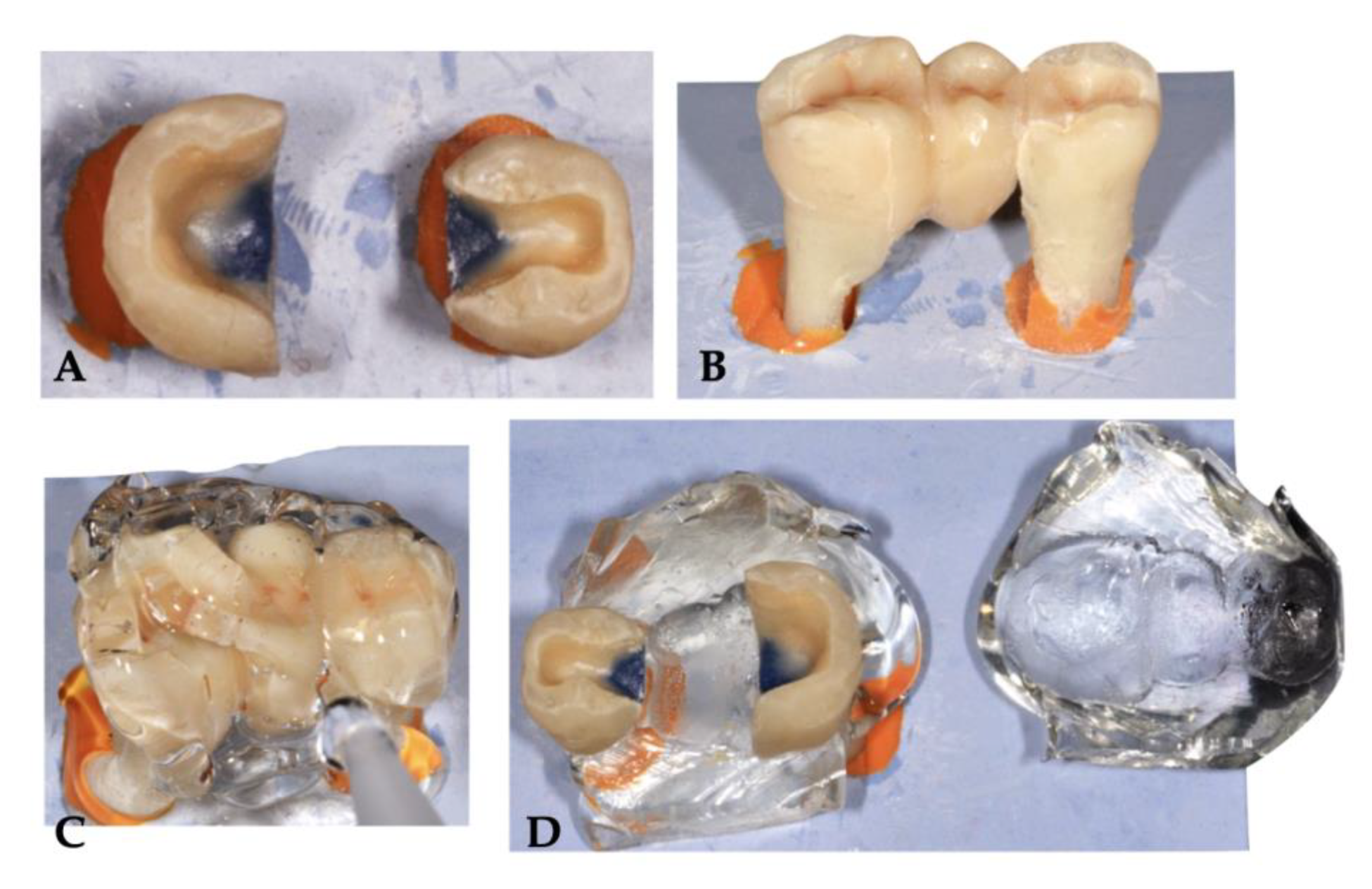
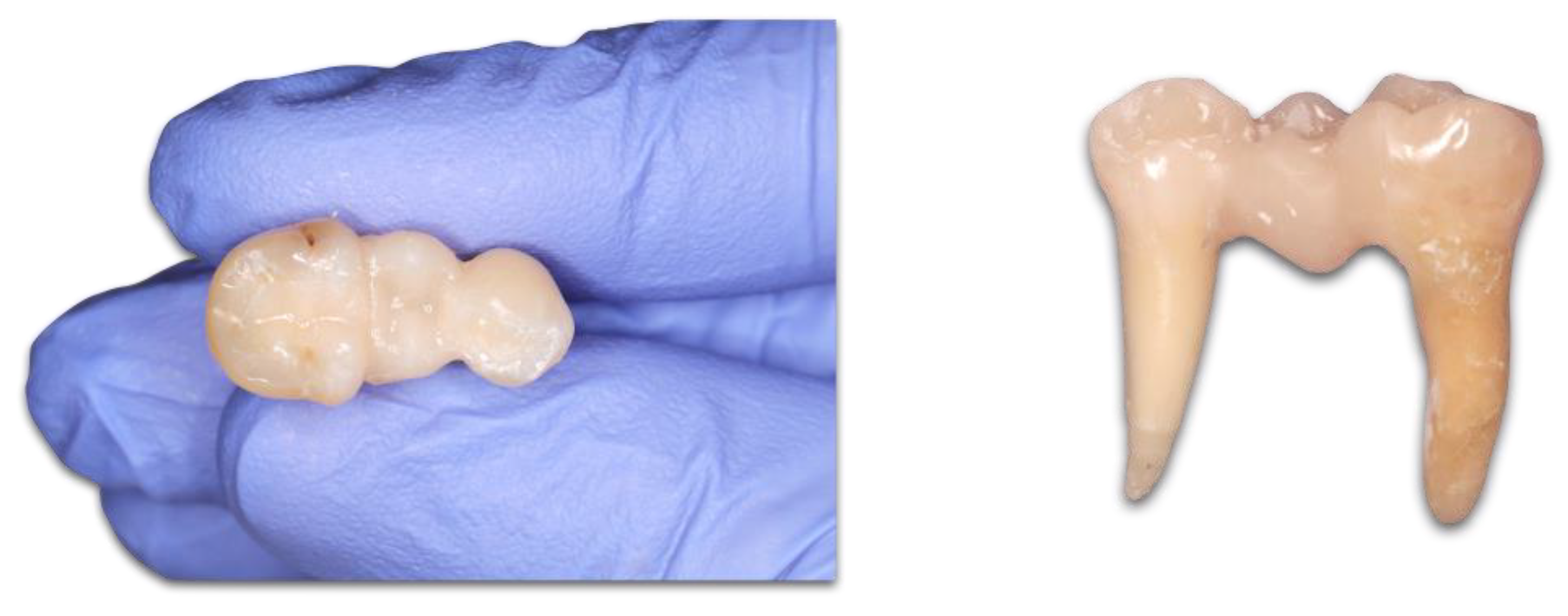
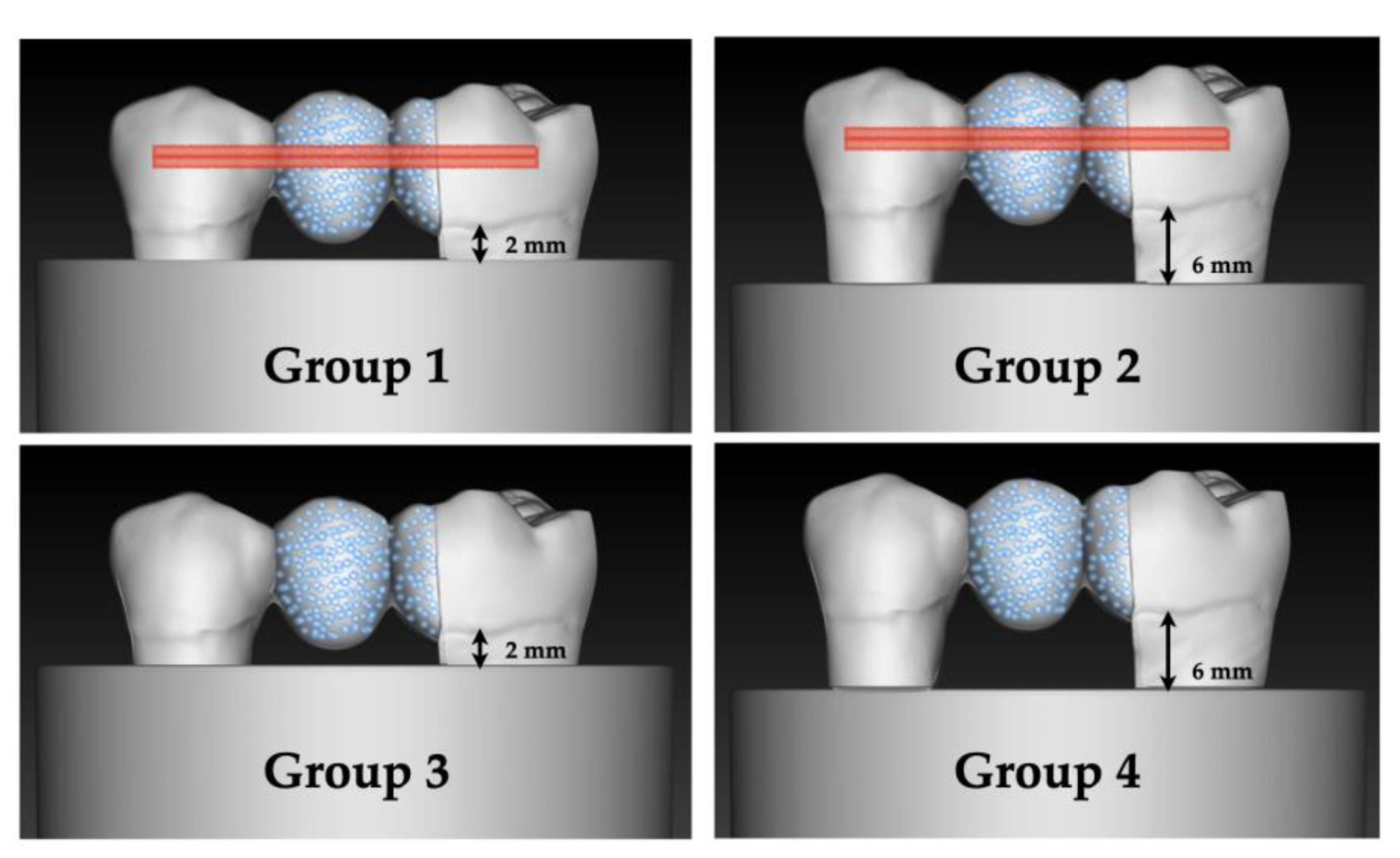

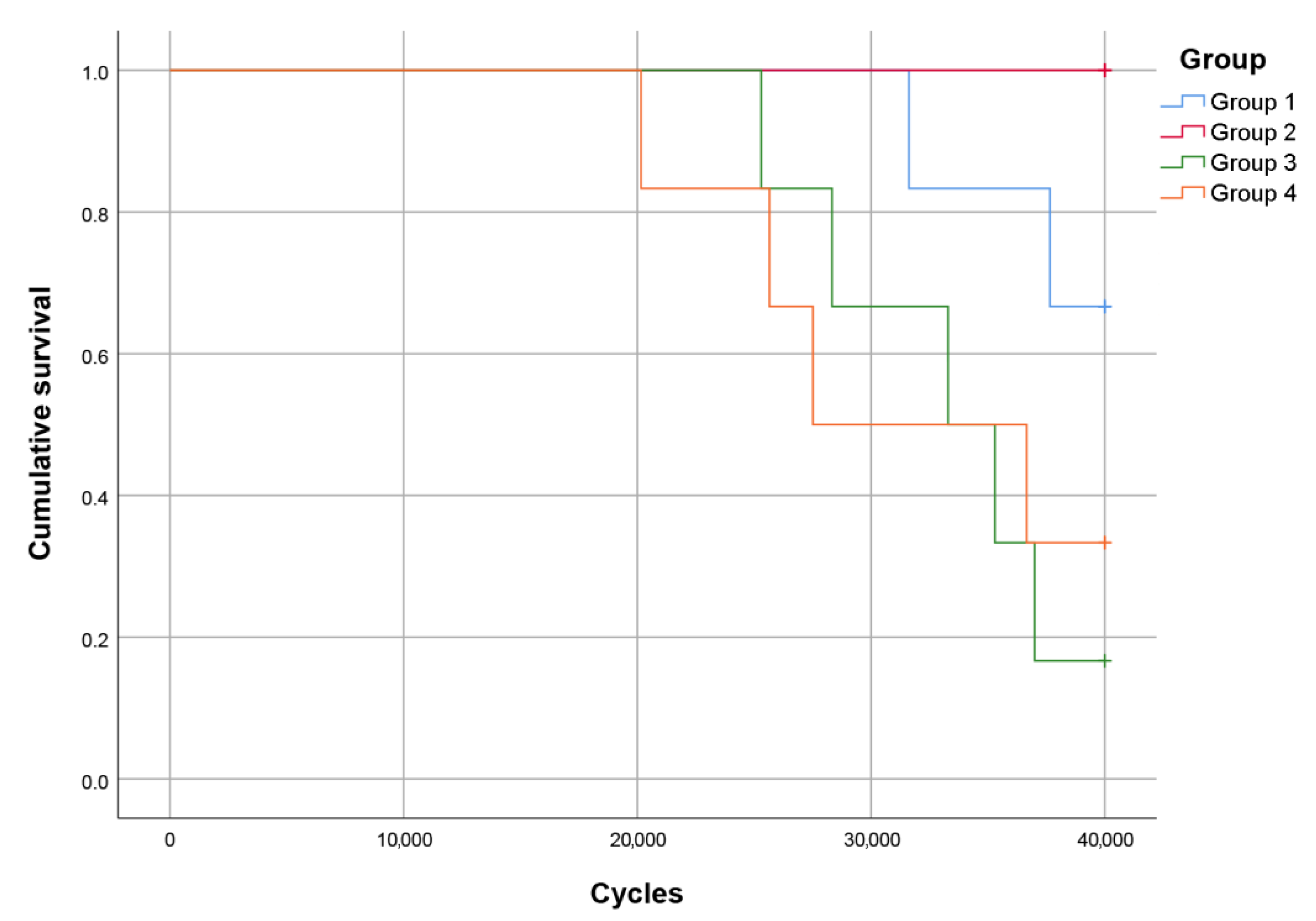
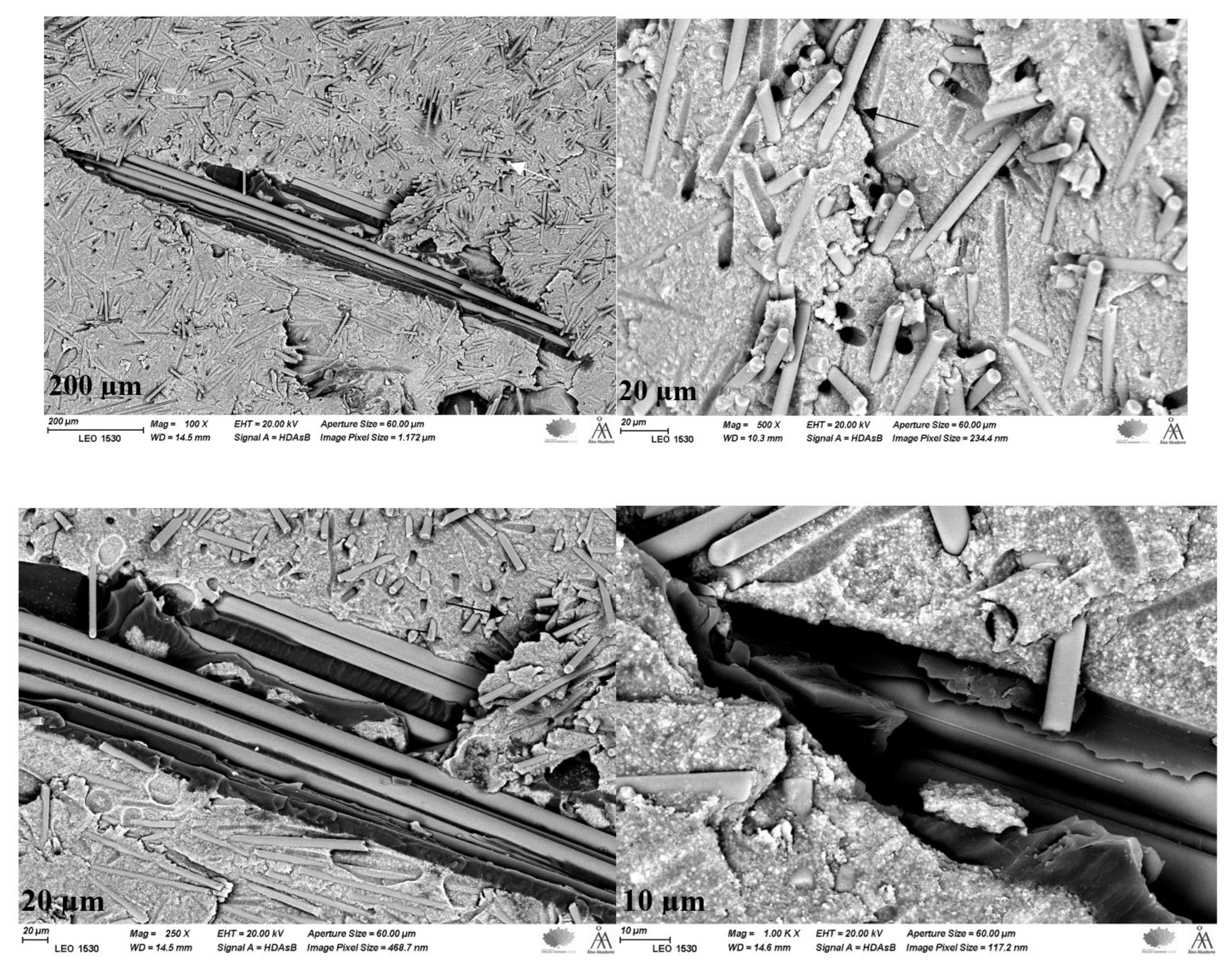
| Material | Manufacturer | Fiber Orientation | Composition/Fibers Feature * | Mechanical Characteristics * |
|---|---|---|---|---|
| EverStick C&B | Stick Tech Ltd., GC Group member, Turku, Finland | Unidirectional | Pre-impregnated bundle (1.5 mm) of silanized E-glass fibers (65 vol%) with Bis-GMA, PMMA. ≈ 4000 individual glass fibres (Ø15 μm) per bundle. | FS: 700–800 MPa FM: 15 GPa FT: not available |
| EverX Flow | GC, Tokyo, Japan | Multi-directional | Bis-EMA, TEGDMA, UDMA, short glass fiber (25 wt%, length 200–300 µm and Ø7 μm), and barium glass. | FS: 146 MPa FM: 9 GPa FT: 2.8 MPa/mm 0.5 |
| Group 1 and 2 | Group 3 and 4 | |
|---|---|---|
| Pontic base | EverX flow dentin shade (discontinuous, short fibers) | EverX flow dentin shade (discontinuous, short fibers) |
| Central glass fibers | EverStick C&B (continuous fibers) | EverX flow dentin shade (discontinuous, short fibers) |
 |  | |
| Occlusal anatomy | EverX flow dentin shade (discontinuous, short fibers) | EverX flow dentin shade (discontinuous, short fibers) |
| Pairwise Comparisons | |||||||||
|---|---|---|---|---|---|---|---|---|---|
| GROUP | Group 1 | Group 2 | Group 3 | Group 4 | |||||
| Chi-Square | Sig. | Chi-Square | Sig. | Chi-Square | Sig. | Chi-Square | Sig. | ||
| Log Rank (Mantel-Cox) | Group 1 | 2.195 | 0.138 | 3.607 | 0.058 | 1.950 | 0.163 | ||
| Group 2 | 2.195 | 0.138 | 8.170 | 0.004 * | 5.568 | 0.018 * | |||
| Group 3 | 3.607 | 0.058 | 8.170 | 0.004 * | 0.041 | 0.839 | |||
| Group 4 | 1.950 | 0.163 | 5.568 | 0.018 * | 0.041 | 0.839 | |||
| Survived | Fractured | Favorable Fracture | Unfavorable Fracture | |
|---|---|---|---|---|
| Group 1 | 4 | 2 | 1 | 1 |
| Group 2 | 6 | 0 | - | - |
| Group 3 | 1 | 5 | 2 | 3 |
| Group 4 | 2 | 4 | 2 | 2 |
Disclaimer/Publisher’s Note: The statements, opinions and data contained in all publications are solely those of the individual author(s) and contributor(s) and not of MDPI and/or the editor(s). MDPI and/or the editor(s) disclaim responsibility for any injury to people or property resulting from any ideas, methods, instructions or products referred to in the content. |
© 2023 by the authors. Licensee MDPI, Basel, Switzerland. This article is an open access article distributed under the terms and conditions of the Creative Commons Attribution (CC BY) license (https://creativecommons.org/licenses/by/4.0/).
Share and Cite
Szabó, V.T.; Szabó, B.; Barcsayné-Tátrai, N.; Mészáros, C.; Braunitzer, G.; Szabó, B.P.; Lassila, L.; Garoushi, S.; Fráter, M. Fatigue Resistance of Dissected Lower First Molars Restored with Direct Fiber-Reinforced Bridges—An In Vitro Pilot Study. Polymers 2023, 15, 1343. https://doi.org/10.3390/polym15061343
Szabó VT, Szabó B, Barcsayné-Tátrai N, Mészáros C, Braunitzer G, Szabó BP, Lassila L, Garoushi S, Fráter M. Fatigue Resistance of Dissected Lower First Molars Restored with Direct Fiber-Reinforced Bridges—An In Vitro Pilot Study. Polymers. 2023; 15(6):1343. https://doi.org/10.3390/polym15061343
Chicago/Turabian StyleSzabó, Veronika T., Balázs Szabó, Noémi Barcsayné-Tátrai, Csongor Mészáros, Gábor Braunitzer, Balázs P. Szabó, Lippo Lassila, Sufyan Garoushi, and Márk Fráter. 2023. "Fatigue Resistance of Dissected Lower First Molars Restored with Direct Fiber-Reinforced Bridges—An In Vitro Pilot Study" Polymers 15, no. 6: 1343. https://doi.org/10.3390/polym15061343
APA StyleSzabó, V. T., Szabó, B., Barcsayné-Tátrai, N., Mészáros, C., Braunitzer, G., Szabó, B. P., Lassila, L., Garoushi, S., & Fráter, M. (2023). Fatigue Resistance of Dissected Lower First Molars Restored with Direct Fiber-Reinforced Bridges—An In Vitro Pilot Study. Polymers, 15(6), 1343. https://doi.org/10.3390/polym15061343










